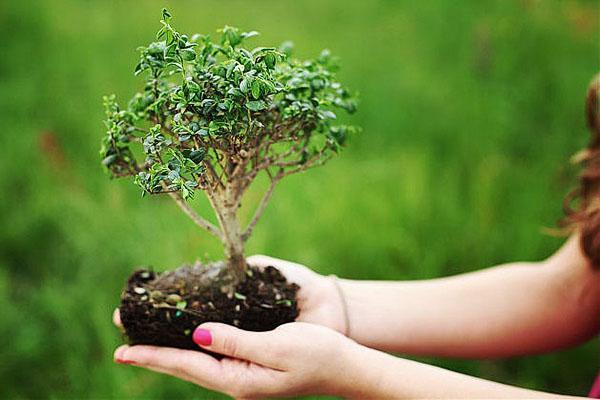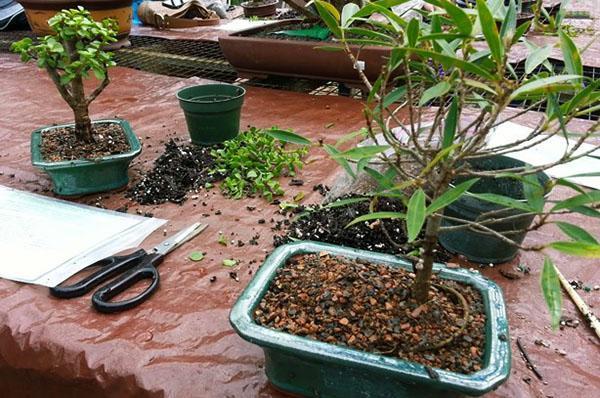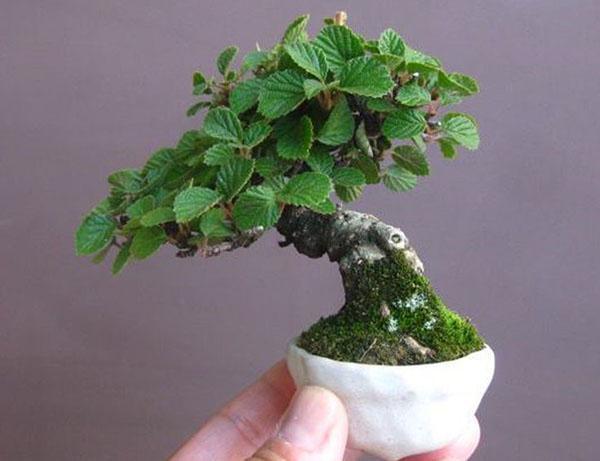Bonsai - a tree on a tray: features of care and growing at home
 According to legend, the Chinese emperor decided to observe his country with his own eyes, for which the craftsmen of the Celestial Empire had to create tiny copies of houses, people and, of course, trees. Bonsai, miniature tree, almost fifteen centuries ago, first conquered Japan, and today this amazing art has conquered the whole world.
According to legend, the Chinese emperor decided to observe his country with his own eyes, for which the craftsmen of the Celestial Empire had to create tiny copies of houses, people and, of course, trees. Bonsai, miniature tree, almost fifteen centuries ago, first conquered Japan, and today this amazing art has conquered the whole world.
Like many centuries ago, the goal of the bonsai grower is to reproduce the creations of nature itself. Reduced copies of oaks, maples, pines, sakura or ficuses have realistic proportions, they live according to the routine established by nature. If a deciduous tree is grown in a pot, it blooms, becomes leafy and goes into winter rest.
Since the artfully shaped resemblance to a real tree is hand-formed, growing and caring for a bonsai is laborious, time-consuming, requiring knowledge, patience and understanding the needs of your green pet.
And yet more and more beginners are enthusiastically undertaking the difficult, but very exciting job. How to grow bonsai at home and take care of a small copy of a real tree?

How to grow bonsai at home: common ways
 If a grower is just beginning to take an interest in bonsai, the easiest way is to purchase a plant already formed, for example, from a ficus or citrus tree. It will help you master all the techniques of leaving from regular watering to pruning and adjusting the shape of the trunk and branches. The experience gained will allow you to move on to more complex tasks.
If a grower is just beginning to take an interest in bonsai, the easiest way is to purchase a plant already formed, for example, from a ficus or citrus tree. It will help you master all the techniques of leaving from regular watering to pruning and adjusting the shape of the trunk and branches. The experience gained will allow you to move on to more complex tasks.
There are several ways to grow bonsai at home:
- through sowing the seeds of the culture you like and the subsequent "upbringing" of the seedling;
- using a rooted cutting;
- the formation of a seedling from a nursery or wildlife;
- transferring to a pot and correcting an already adult cultivated or wild specimen.
The fastest of these methods is the formation of the crown and root system of a one- or two-year-old seedling. Such a plant already has developed roots, while its ground part gives room for imagination and can be modified according to the plans of the grower.
Enthusiasts interested in how to grow bonsai from seeds should know that this path is the longest, but also rewarding. Here, a person has control over the plant literally from the moment the seed spits, and it is easier to change the shape of shoots and roots because of their flexibility.
You don't have to choose an exotic tree or shrub. The main thing is that the plant has small leaves and a small annual growth, otherwise it will be much more difficult to "tame" the future bonsai tree.
Choosing the right tree for bonsai
What types of plants are suitable for bonsai, Japanese-style tree? To get an attractive tree quickly enough, you can pay attention:
- for indoor citrus varieties, for example, calamondin or regular lemon;

- on a dwarf pomegranate;

- on the incredibly common and unpretentious ficus of Benjamin;

- for decorative varieties of apple trees;

- on the willow;

- on undersized pines;
- for a variety of maple species.

The selection of trees suitable for bonsai is incredibly large, and many of them are indigenous to Russia and are found in gardens, parks, city squares and forests. Great compositions come from barberry and irgi, hawthorn, acacia and birch, elder and linden, euonymus and oak.
Before growing bonsai, based on the type of plant, determine its future height and style.
How to grow bonsai from seeds?
 The seeds of trees and shrubs suitable for bonsai are divided into two types. Some crops are immediately ready for germination, but evolution has laid down a hibernation period in the “program” of many species, when the sprout waits out the cold season. At home, stratification will help simulate winter.
The seeds of trees and shrubs suitable for bonsai are divided into two types. Some crops are immediately ready for germination, but evolution has laid down a hibernation period in the “program” of many species, when the sprout waits out the cold season. At home, stratification will help simulate winter.
The seeds of trees for Japanese bonsai are laid in wet sand or sphagnum moss for 3-5 months, after which the container is placed in the refrigerator. At a slight positive temperature in a humid environment, the seed prepares for growth. When it is transferred to warmth, the sprout quickly awakens. For evergreen species and plants with seeds that have a particularly durable shell, heat or temperature contrast is used to awaken.
Sowing seeds is carried out from spring to early autumn. Seedlings obtained in the second half of summer already need illumination, which is simply irreplaceable in autumn and winter.
For germination and the first months of life of seedlings, a light sandy-peat substrate or soaked peat tablets that have absorbed moisture are used. Until a sprout appears on the surface, the container should be in the dark under the film. The air temperature is selected depending on the bonsai tree being grown.
 To avoid the formation of condensation and rot, the greenhouse is ventilated. When seedlings appear, they provide a small access of fresh air inside and transfer the seedlings to the light. As needed, seedlings are watered and fertilized with complex compounds. When the plant reaches a height of 10–12 cm, it is transplanted.
To avoid the formation of condensation and rot, the greenhouse is ventilated. When seedlings appear, they provide a small access of fresh air inside and transfer the seedlings to the light. As needed, seedlings are watered and fertilized with complex compounds. When the plant reaches a height of 10–12 cm, it is transplanted.
 At this stage, the main root is shortened by one third to slow down the vertical growth of the tree. They immediately begin to form the future trunk, for which they use copper wire.
At this stage, the main root is shortened by one third to slow down the vertical growth of the tree. They immediately begin to form the future trunk, for which they use copper wire.
Choosing a pot and soil for bonsai
 The bonsai tree is called tray-grown for a reason. To limit the growth of the pet, it is planted in a deliberately small and shallow container, simultaneously forming and cutting off part of the root system.
The bonsai tree is called tray-grown for a reason. To limit the growth of the pet, it is planted in a deliberately small and shallow container, simultaneously forming and cutting off part of the root system.
When choosing a pot for bonsai, it must be borne in mind that over the years the tree becomes heavy and, especially with an irregular, inclined or cascading shape, can lose stability. Therefore, for bonsai with sizes from a few centimeters to 9 meters, massive, often ceramic pots, bowls or containers of various shapes and styles are traditionally made.
 There should be more than one drain hole at the bottom of the container. They are used not only to drain water, but also to fix the plant.
There should be more than one drain hole at the bottom of the container. They are used not only to drain water, but also to fix the plant.
To protect the plant and protect it from fungal infection of the root system, treating the bonsai pot with a hot solution of potassium permanganate or scalding with boiling water will help.
Bonsai soil is not only designed to provide the plant with nutrition and retain moisture, it should help the roots to anchor in a relatively small pot volume. Therefore, for miniature copies of real oaks, lindens, lemons, maples and other trees, a special substrate is used.
 In Japan, for many centuries, such a mixture based on certain types of clay has been called akadama. For greater nutritional value and looseness, fertile soil and sand are added to the granular substance:
In Japan, for many centuries, such a mixture based on certain types of clay has been called akadama. For greater nutritional value and looseness, fertile soil and sand are added to the granular substance:
- For deciduous species of bonsai trees, a substrate is recommended with the inclusion of 7 parts of sod land and 3 parts of coarse washed sand.
- Flowering crops are grown on a mixture of 7 parts of sod land, three parts of sand and 1 part of highly nutritious humus.
- Conifers, the most popular among bonsai lovers, need a particularly loose soil, for which they take 3 parts of sod soil and 2 parts of washed sand.
 Before filling the pot, the bonsai soil is sorted out, removing foreign inclusions that can damage the roots, sifted and sterilized. At the bottom of the container, a drainage layer is arranged to drain excess moisture.
Before filling the pot, the bonsai soil is sorted out, removing foreign inclusions that can damage the roots, sifted and sterilized. At the bottom of the container, a drainage layer is arranged to drain excess moisture.
Bonsai tree care at home
 It is not enough to buy a miniature tree, get a young seedling or root a stalk of the breed you like. It is important to know how to care for a bonsai tree.
It is not enough to buy a miniature tree, get a young seedling or root a stalk of the breed you like. It is important to know how to care for a bonsai tree.
Constantly limiting growth, forming a crown and growing bonsai in a small pot, a person completely changes the life of a tree or shrub. Therefore, caring for such a crop is strikingly different from caring for other indoor plants.
The main task of the grower is to establish watering of the bonsai, which is not easy to cope with with a small volume of soil and a shallow pot filled with roots.
Previously, flower growers had only a special shape of a watering can at their disposal or the ability to immerse a bonsai pot in a bowl of water to wet the soil from below. Today, irrigation of plants or drip irrigation is actively used, which makes it possible to moisten the soil under the bonsai in doses and without the risk of erosion.
 For irrigation, take only soft, melted or settled water. During the growing season, plants need more moisture, with the onset of autumn and the approach of the dormant period, watering is reduced and carried out less often, focusing on the state of the substrate.
For irrigation, take only soft, melted or settled water. During the growing season, plants need more moisture, with the onset of autumn and the approach of the dormant period, watering is reduced and carried out less often, focusing on the state of the substrate.
Top dressing is carried out at intervals of 2-3 weeks, using their mixtures for different crops and seasons. For Japanese bonsai trees, there are algae-based mineral supplements.
Plants cannot be left without food, but it is equally important not to overfeed the bonsai. Therefore, when caring for bonsai trees at home, top dressing is applied very carefully:
- in spring, at maximum growth intensity, include twice as much in fertilizer nitrogenthan potassium and phosphorus;
- in summer, the proportions remain the same, but the concentration is halved;
- closer to autumn, especially for deciduous crops, the content of potassium and phosphorus is doubled, and nitrogen, on the contrary, is reduced.
- flowering and fruit-bearing trees and shrubs need more potassium to form buds and ovaries.
 With the arrival of winter, nothing changes for exotic evergreens, but conifers and deciduous trees must prepare for wintering. How to care for a bonsai tree in winter? If the climate permits, they are left outside or brought onto unheated terraces. The root system in a small bonsai pot may be the first to suffer, so it is additionally covered, and the soil is slightly dried. With the onset of spring, the plant wakes up and again needs watering, feeding and the formation of a crown and roots, which is mandatory for bonsai.
With the arrival of winter, nothing changes for exotic evergreens, but conifers and deciduous trees must prepare for wintering. How to care for a bonsai tree in winter? If the climate permits, they are left outside or brought onto unheated terraces. The root system in a small bonsai pot may be the first to suffer, so it is additionally covered, and the soil is slightly dried. With the onset of spring, the plant wakes up and again needs watering, feeding and the formation of a crown and roots, which is mandatory for bonsai.